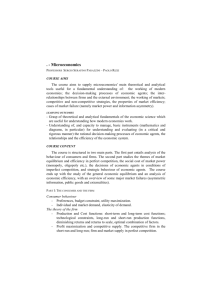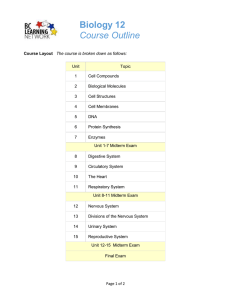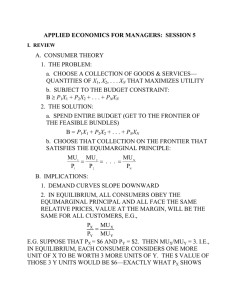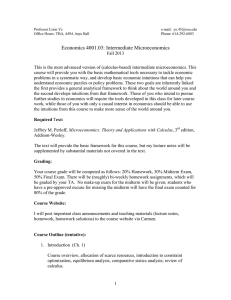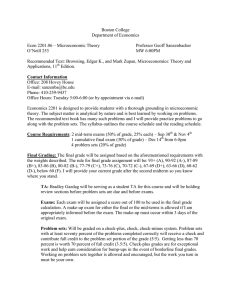Fall 2011 Department of Economics, University of Utah ECON 4010/6010 (Section 002)
advertisement
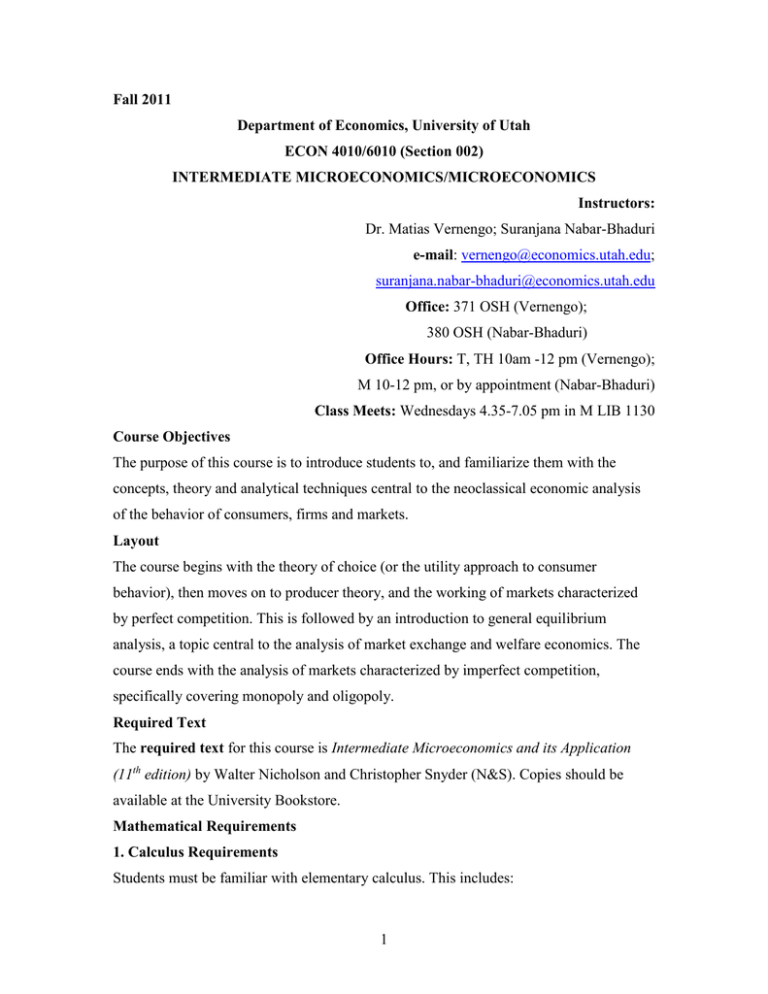
Fall 2011 Department of Economics, University of Utah ECON 4010/6010 (Section 002) INTERMEDIATE MICROECONOMICS/MICROECONOMICS Instructors: Dr. Matias Vernengo; Suranjana Nabar-Bhaduri e-mail: vernengo@economics.utah.edu; suranjana.nabar-bhaduri@economics.utah.edu Office: 371 OSH (Vernengo); 380 OSH (Nabar-Bhaduri) Office Hours: T, TH 10am -12 pm (Vernengo); M 10-12 pm, or by appointment (Nabar-Bhaduri) Class Meets: Wednesdays 4.35-7.05 pm in M LIB 1130 Course Objectives The purpose of this course is to introduce students to, and familiarize them with the concepts, theory and analytical techniques central to the neoclassical economic analysis of the behavior of consumers, firms and markets. Layout The course begins with the theory of choice (or the utility approach to consumer behavior), then moves on to producer theory, and the working of markets characterized by perfect competition. This is followed by an introduction to general equilibrium analysis, a topic central to the analysis of market exchange and welfare economics. The course ends with the analysis of markets characterized by imperfect competition, specifically covering monopoly and oligopoly. Required Text The required text for this course is Intermediate Microeconomics and its Application (11th edition) by Walter Nicholson and Christopher Snyder (N&S). Copies should be available at the University Bookstore. Mathematical Requirements 1. Calculus Requirements Students must be familiar with elementary calculus. This includes: 1 i) calculating the derivatives of functions involving a single variable and two variables; ii) the first-order condition for determining the minimum or maximum of functions involving a single variable and two variables. 2. Other Math Requirements Besides elementary calculus, students must be familiar with: i) calculating the slopes of linear and non-linear functions, ii) graphing linear and simple non-linear functions; iii) graphing simple functions involving two variables; iv) solving systems of simultaneous equations; and v) factoring quadratic functions and solving quadratic equations A review of topics (i) to (iv) can be found in the Appendix to Chapter 1 of the text. I shall briefly review each topic when needed during the course. A hand-out for topic (v) will be posted on WebCT. Method of Evaluation 1. Two Midterm Exams – 50% There will be two midterm exams that will together account for 50% of the final grade. Each midterm will carry 25 points and will be held during our regular class time. The duration of each midterm exam will be 1 hour and 20 minutes. I will give a two week’s notice before each midterm. The first midterm will cover the theory of choice (Topic 1on the Syllabus), and the second midterm will cover producer theory (Topic 2 on the Syllabus). 2. Final Exam -50% The Final Exam will be held on Wednesday, December 14 from 6 to 8 pm, and will account for 50% of the final grade. The focus of the Final Exam will be on topics covered after the second Midterm, and will carry 50 points. At the end of the course, your final grade will be the sum of the scores made on the two midterms and the final, and nothing else. The grade conversion scheme, (the conversion of the cumulative numerical score into a letter grade) will be as follows: i) 85 and above = A; ii) 80 to 84 = A-; 2 iii) 75 to 79 = B+; iv) 70 to 74 = B; v) 65 to 69 = B-; vi) 60 to 64 = C+; vii) 55 to 59 = C; viii) 50 to 54 = C-; ix) 35 to 49 = D; and x) Below 35 =E. Required Work for this Class 1) At the end of each week, I will send out an e-mail through WebCT, summarizing the list of topics covered during the week, and listing the topics/chapter(s) that you are required to read for the next week. I will also post a problem set that deals with the topics covered during the week. Please check WebCT regularly. While you do not have to submit the Problem Sets, these Problem Sets will be indicative of the kinds of questions/problems that will appear on the exams. It is therefore VERY IMPORTANT that you spend sufficient time working through the questions/problems, and make sure that you are eventually able to answer them without looking at the solutions. If there are things that you have difficulty with, please feel free to clarify these in class, or during office hours. 2) Before each exam, I will post a sample exam on WebCT. The questions on the sample exams will be based on the relevant problem sets. These sample exams will provide an indication of the number of questions that will appear on the actual exams, and of how the various topics will be distributed across different questions. But, for every exam, you are required to be familiar with all the questions/problems in the various problem sets, even if similar questions/problems do not appear on the sample. Please note that the distribution of the topics on the actual exam may differ slightly from that given in the sample. 3 Topics to be Covered (The instructor reserves the right to make minor changes, if required) 1. The Theory of Choice I) Introduction to the Utility Approach The concept of utility; assumptions underlying the utility approach to consumer theory; indifference Curves; the Marginal Rate of Substitution; the Budget Constraint; the Utility Maximization Problem. II) Demand Functions; Income Effects; Price Effects and the Individual Demand Curve Defining the demand function; homogeneous demand function; the income effect for normal goods and inferior goods; the price effect -a combination of the substitution effect and the income effect; the price effect for normal goods and inferior goods; Giffen’s Paradox; using the price effect and utility maximizing behavior to derive individual demand curves. (N&S, Chs 2, 3) 2. Theory of Production I)Production Function; Marginal Product; Average Product; Isoquants; the Rate of Technical Substitution; Returns to Scale; Impact of Technical Progress on Input Choice; the Fixed Proportions (or Leontief) Production Function. II) Cost Minimization Defining the Cost Minimization Problem; iso-cost lines; determination of the costminimizing input choice; the expansion path; cost functions and returns to scale; the short-run versus the long-run; fixed and variable costs. III) Profit Maximization Economic Profit versus Accounting Profit; Defining the Profit Maximization Problem; determination of the profit maximizing output level; the marginal revenue curve of a price-taking firm; profit maximization under price-taking behavior; the shutdown point; the short-run supply curve of a price taking firm. (N&S, Chs 6, 7, 8) 3. Perfectly Competitive Markets Three time horizons-the very short run, the short-run and the long-run; the very short-run supply curve; pricing under perfect competition in the very short-run; the function of the 4 market price in the very short-run; the short-run supply curve; price determination under perfect competition in the short-run; the functions of the market price in the short-run; entry and exit in the long-run; the long-run equilibrium in a perfectly competitive market; the long-run supply curve. (N&S, Ch 9) 4. General Equilibrium Analysis General equilibrium versus partial equilibrium; need for general equilibrium analysis; the two-commodity general equilibrium model; the first theorem of welfare economics; the Edgeworth Box Diagram of exchange; mutually beneficial trades; Pareto efficient allocations and the Contract Curve; the efficiency-equity trade-off; the second theorem of welfare economics. (N&S, Ch 10) 5. Market Power I) Monopoly Causes of monopolies; the marginal revenue curve of a monopolist; profit maximization under monopoly; the inefficiency of resource allocation under monopoly; distributional effects and the deadweight loss of monopoly; price discrimination; two examples of price discrimination- perfect price discrimination and market separation. II) Oligopoly The Cournot model; Nash equilibrium in the Cournot model; the Bertrand model with differentiated products. (N&S, Chs, 11, 12) Class Policies 1. I would like this class to be as participatory as possible. Do not hesitate to ask questions during class if you do not understand something, or come and see me during office hours. If you are unable to make it during the scheduled office hours, you can always send me an e-mail, and we can decide on another time. 2. The University of Utah seeks to provide equal access to its programs, services and activities for people with disabilities. If you need accommodations in the class, sufficient notice must be given to the Center for Disability Services (162 Union Building, Tel no: 5 581-5020). The CDS will work with you and the instructor to make arrangements for accommodations. 3. In the event that weather or other reasons prevent me from arriving on time, the department will be notified as soon as possible and a departmental representative will inform you as to when the class will begin. 4. All students are expected to maintain professional behavior in the classroom, as per the Student Code, spelt out in the Student Handbook. Students also have specific rights in the classroom, under the Student Code. The Student Code also specifies proscribed conduct, involving cheating on tests, plagiarism and/or collusion, fraud, theft, etc. Students should read the code carefully, and know that they are responsible for the content. As per the Faculty Rules and Regulations, it is the responsibility of the instructor to enforce responsible classroom behaviors, and I will do so, beginning with verbal warnings, and progressing (if warranted) to dismissal from class, and a failing grade. Students have the right to appeal against such action to the Student Behavior Committee. 5. Regular attendance is strongly recommended. There will be topics where I depart from the approach of the text. In addition, some of the problems in the problem sets will be worked out in class, and the solutions to these problems will not be posted in the solution sets. If you are absent for a particular class, you should get lecture notes from classmates. While you are free to come and see me to clarify things that you may have difficulty with, there will be no make-up classes. Prolonged absence from classes and/or during exams will adversely affect your grade. Absence on any exam without permission and/or a valid reason (see number 7 below) will result in a score of zero for that exam. 6. If you come to class, you are expected to remain for the entire length of the class, and not leave during breaks, or while the class is in session without prior permission. Students who fail to observe this will receive a verbal warning the first time around. Those who fail to observe this on more than one occasion will have 2 points deducted from their final grade. 7. Exams must be taken on the scheduled dates. You cannot take a make-up exam without permission. For permission, you must give me notice (if at all possible) before 6 the class takes the exam. For work-related reasons (e.g. mandatory meetings; workrelated travel), you must submit written evidence. Besides work-related reasons, I will allow you to take a make-up exam only under the following circumstances: i) You are very ill and are under the care of a doctor. For this, you must provide a doctor’s note certifying that you were not in a condition to take the exam on the scheduled day. ii) An immediate family member is very ill, and you provide written evidence from a doctor verifying that this is so. iii) You are participating in a university-sponsored extra-curricular activity, and you supply written evidence of this. 8. Extra time during exams will not be granted if you are late. 9. Each exam must be written in an Examination Blue Book. You must use a separate blue book for every exam. Any exam written in a blue book containing a previous exam will lose 5 points. 10. You must carry a calculator for each exam. However, graphing calculators are not allowed. Cell phones must be switched off during all exams, and cannot be used to perform calculations. 11. The use of cell phones including texting/messaging, and the reading of newspapers/novels/magazines is prohibited during class. You should either switch off your cell phone, or keep it on the Silent Mode. Dr. Matias Vernengo Suranjana Nabar-Bhaduri 7

